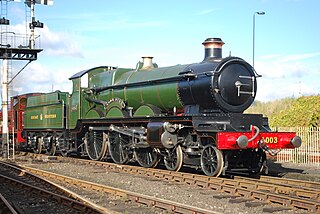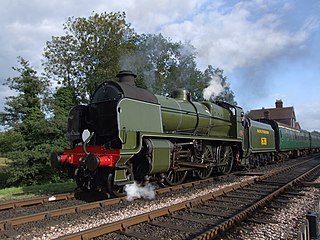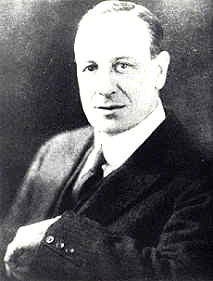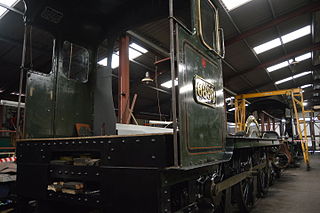
The Great Western Railway 4000 or Star were a class of 4-cylinder 4-6-0 passenger steam locomotives designed by George Jackson Churchward for the Great Western Railway (GWR) in 1906 and introduced from early 1907. The prototype was built as a 4-4-2 Atlantic. They proved to be a successful design which handled the heaviest long-distance express trains, reaching top speeds of 90 mph, and established the design principles for GWR 4-cylinder classes over the next twenty-five years.
George Jackson Churchward was an English railway engineer, and was chief mechanical engineer of the Great Western Railway (GWR) in the United Kingdom from 1902 to 1922.

The GWR 4100 Class was a class of steam locomotives in the Great Western Railway (GWR) of the United Kingdom.

The SR Z class was an 0-8-0T 3-cylinder tank engine designed by Richard Maunsell and intended for heavy shunting on the Southern Railway, the first eight entering into service in 1929. It was a successful design and would have been built in greater numbers, but an order for a further ten was cancelled in 1930 due to the reduction in freight traffic as a result of the Great Depression.
The SR N15X class or Remembrance class were a design of British 4-6-0 steam locomotives converted in 1934 by Richard Maunsell of the Southern Railway from the large LB&SCR L class 4-6-4 tank locomotives that had become redundant on the London–Brighton line following electrification. It was hoped that further service could be obtained from these locomotives on the Southern's Western Section, sharing the duties of the N15 class locomotives. The locomotives were named after famous Victorian engineers except for Remembrance, which was the LBSCR's memorial locomotive for staff members who died in the First World War.

The LSWR N15 class was a British 2–cylinder 4-6-0 express passenger steam locomotive designed by Robert W. Urie. The class has a complex build history spanning three sub-classes and eight years of construction from 1918 to 1927. The first batch of the class was constructed for the London and South Western Railway (LSWR), where they hauled heavy express trains to the south coast ports and further west to Exeter. After the Lord Nelsons, they were the second biggest 4-6-0 passenger locomotives on the Southern Railway. They could reach speeds of up to 90 mph (145 km/h).
The Great Western Railway 3800 Class, also known as the County Class, were a class of 4-4-0 steam locomotives for express passenger train work introduced in 1904 in a batch of ten. Two more batches followed in 1906 and 1912 with minor differences. They were designed by George Jackson Churchward, who used standard components to produce a four-coupled version of his Saint Class 4-6-0s.

The Great Western Railway 2900 Class or Saint Class was built by the Great Western Railway's Swindon Works. incorporated several series of 2-cylinder passenger steam locomotives designed by George Jackson Churchward and built between 1902 and 1913 with differences in the dimensions. The majority of these were built as 4-6-0 locomotives; but thirteen examples were built as 4-4-2. They proved to be a successful class which established the design principles for GWR 2-cylinder classes over the next fifty years.

The Great Western Railway (GWR) 6800 Class or Grange Class was a mixed-traffic class of 4-6-0 steam locomotive, built to replace the GWR 4300 Class 2-6-0. There were 80 in the class, all built at the Swindon works, using some reconditioned parts from withdrawn 4300 Class locomotives.

The SR U class are 2-6-0 steam locomotives designed by Richard Maunsell for passenger duties on the Southern Railway (SR). The class represented the penultimate stage in the development of the Southern Railway's 2-6-0 "family", which improved upon the basic principles established by GWR Chief Mechanical Engineer (CME) George Jackson Churchward for Great Western Railway (GWR) locomotives. The U class design drew from experience with the GWR 4300s and N classes, improved by applying Midland Railway ideas to the design, enabling the SECR to influence development of the 2-6-0 in Britain.

Charles Benjamin Collett was Chief Mechanical Engineer of the Great Western Railway from 1922 to 1941. He designed the GWR's 4-6-0 Castle and King Class express passenger locomotives.

The B4 class were 4-4-0 steam locomotives for express passenger work on the London, Brighton and South Coast Railway. They were designed by R. J. Billinton and were either built at Brighton works 1899–1902 or else by Messrs Sharp, Stewart and Company in 1901. Twelve members of the class were rebuilt from 1922 to 1924 by L. B. Billinton with a larger boiler, cylinders and a superheater. The rebuilt locomotives were classified B4X.

The Dean Single, 3031 Class, or Achilles Class was a type of steam locomotive built by the British Great Western Railway between 1891 and 1899. They were designed by William Dean for passenger work. The first 30 members of the class were built as 2-2-2s of the 3001 Class.

The SECR N class was a type of 2-6-0 ("mogul") steam locomotive designed in 1914 by Richard Maunsell for mixed-traffic duties on the South Eastern and Chatham Railway (SECR). Built between 1917 and 1934, it was the first non-Great Western Railway (GWR) type to use and improve upon the basic design principles established by GWR Chief Mechanical Engineer (CME) George Jackson Churchward. The N class was based on the GWR 4300 Class design, improved with Midland Railway concepts.

The SECR N1 class was a type of 3-cylinder 2-6-0 ('mogul') steam locomotive designed by Richard Maunsell for mixed traffic duties, initially on the South Eastern and Chatham Railway (SECR), and later operated for the Southern Railway (SR). The N1 was a development of the basic principles established by the Great Western Railway's (GWR) Chief Mechanical Engineer (CME) George Jackson Churchward and by Maunsell's previous N class design.

No.6880 Betton Grange is a steam locomotive which is under construction as a "new-build" project, originally based on the Llangollen Railway in Denbighshire, Wales, then subsequently at Tyseley Locomotive Works. Described as "building the 81st Grange", the project started in 1998, and the locomotive was earlier expected to be operational by 2013, but subsequently by Autumn 2021. All of the original GWR 6800 Class Grange locomotives were withdrawn for scrap by the end of 1965; this project is a creation, from an assemblage of original GWR and newly manufactured components, of a member of this class.

The SECR K class was a type of 2-6-4 tank locomotive designed in 1914 by Richard Maunsell for express passenger duties on the South Eastern and Chatham Railway (SECR), which operated between London and south-east England. The Southern Railway (SR) K1 class was a three-cylinder variant of the K class, designed in 1925 to suit a narrower loading gauge. They were among the first non-Great Western Railway (GWR) types to use and improve upon the basic design principles of power and standardisation established by GWR Chief Mechanical Engineer (CME) George Jackson Churchward. The locomotives were based on the GWR 4300 class, improved by the Midland Railway's ideals of simplicity and ease of maintenance.
Harold Holcroft was an English railway and mechanical engineer who worked for the Great Western Railway (GWR), the South Eastern and Chatham Railway (SECR) and the Southern Railway (SR).

The Holcroft valve gear was a type of conjugated valve gear designed and patented by Harold Holcroft and used on three-cylinder steam locomotives of the South Eastern & Chatham Railway (SECR). It bore many similarities to the Gresley conjugated valve gear, which it predated, as eventually used on all Gresley's three cylinder designs. It varied from the Gresley method of operation by using the combination lever assembly instead of the valve spindles to drive the middle cylinder of a three-cylinder design. This had operational advantages over Gresley's design, namely eliminating the problems of flexure, bush wear and the influence of heat in the valve spindles.
The GS&WR 400 class or CIE class B2/B2a were a class of ten 4-6-0 steam locomotives built for the Great Southern & Western Railway (GS&WR) between 1916 and 1923 for express passenger duties on the Dublin to Cork main line. They proved initially unreliable but rebuilds from four to two cylinders between 1927 and 1937 for the seven survivors produced locomotives yielding satisfactory performance with the last two being withdrawn in 1961.















